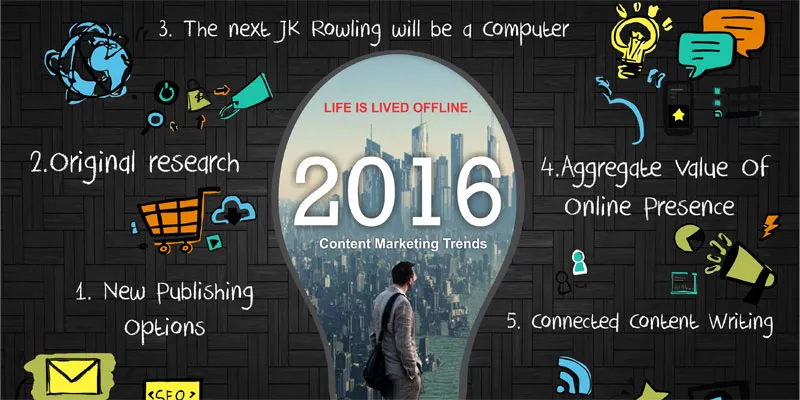Top five content marketing trends for 2016
There is an overload of data mining happening online. Marketers will need to remember in 2016 that Life Is Lived Offline.
The journey from trigger to purchase is not fully online. The tendency to base every marketing strategy on the basis of clicks and searches alone will be proved faulty.
This understanding is the most important foundation for content marketing and content-led marketing in 2016. We have defined earlier that

Native advertising makes customers look you up.
Content marketing can ‘convert’ the customers who look you up.
This article pertains to:
- Content marketing.
- Content-led marketing.
Content marketing implies that you own the media, whereas content-led marketing means that you are buying media space to put out your content rather than advertisements.
Now that we have the context set, here are the top five trends to watch out for in 2016.
- All social media will offer new publishing options
LinkedIn and Facebook are already doing it. YouTube was the first to realise that UGC is the future. By allowing people to host channels and pages, social media platforms are getting massive quantities of free content posted on their platform everyday. In 2016, newer platforms will allow for content sharing, and publishing, free of cost.
Word of caution: Choose the platform where you think you can be a star and pursue it. You cannot be everywhere.
2.Original research will be back in fashion
It’s tough to use research and fashion in one sentence. But the keyword is “original”.
To capture consumer insights in a massive, real-time process and converting this into content strategies is something that will dominate marketing conversations in 2016.
Every brand will have to do this, even if they don’t have the time or resources to launch a full-scale experiment or research initiative, they will start with something small but original research.Brands will go offline and observe people.
The goal will be to present radically refreshing to readers and followers – something they can’t get anywhere else.
- The next JK Rowling will be a computer
Robots, with the help of algorithms, have started writing today. This currently applies to simple reporting like weather forecasts. The more complex writing still needs a human brain. 2016 will see many more automated algorithms.
However, this will happen only in the super-large corporations with massive content requirements.
What will happen more commonly is that intricate software will be able to take bite-sized information from millions of social profiles and piece them together to form engaging, timely stories. For instance, there may be someone who will build a story on how the world celebrated Christmas, with 1,000 images and text inserts from all over the world.
The next blockbuster book or movie could see offline, user experiences translated to an online world.
Algorithms and robot developers, for content marketing will itself become a business model.
- Brands will measure aggregate value of online presence (AVOP)
In the past, if you were a website that hosted the highest volume of quality written content, you would have a vast influence. This has changed. Today, an aggregation of social media, with a sum total of a great network, variations in news formats like videos, news, infographics, etc., that can reach an audience across multiple mediums is what will work.
Thus,2016 will have brands thinking – lets run this contest only for our readers or our fans. So while businesses will straddle continents, communities of interested parties will come together on social media to deliver localised value.
Each brand will invest in offline and online community development. Agencies will start talking in terms of AVOP to measure how many people a brand can reach on its own, and hence how many it needs to reach by buying media.
- Long-form, connected content writing will be back
Google’s knowledge graph, a compilation that comes on the right hand side of a search, when you search for a very famous person, is an interesting development.
It clearly seems that Google is moving from being an information engine to a knowledge engine. So what does that mean for brands? Every piece of content that you put out has to connect with other pieces of related content. And there is tremendous opportunity for long-form, in-depth content.
For example, if you're writing about a mobile phone, identify all the keywords that people use to look for that phone and put a minimum percentage for those to go into your content without affecting flow and continuity.
Check out the videos in Google Inside Search. Samples like Zack Matere’s ‘growing knowledge’ are the new ways to encourage your users to tell stories. Every brand can benefit from a visual evocation of user experiences.
Summingup
In 2016, more than ever before, quality of content trump quantity, and only the best will survive. Video and visual storytelling will rule. We will also re-invent the old, to some extent. Ironically enough, a personal touch in the online world will make the difference, soon!







